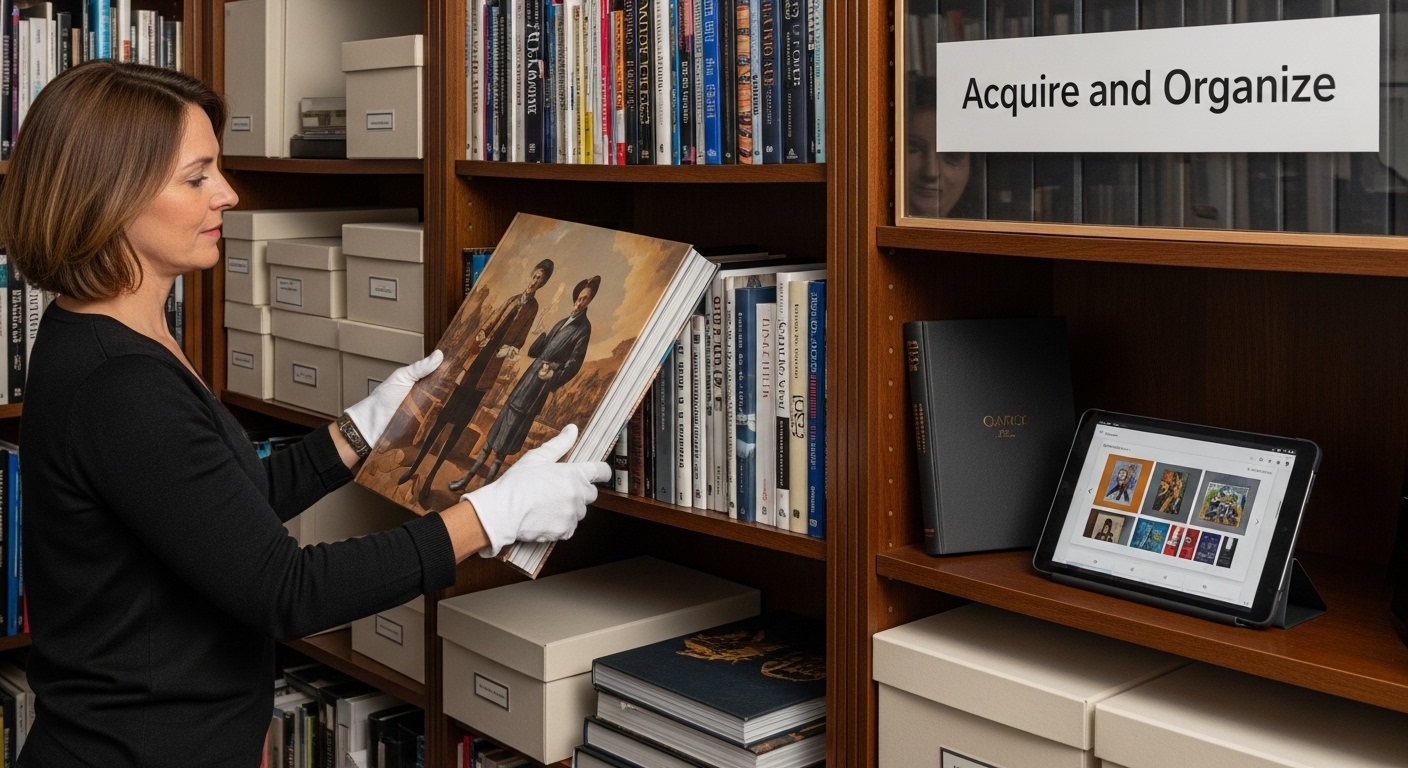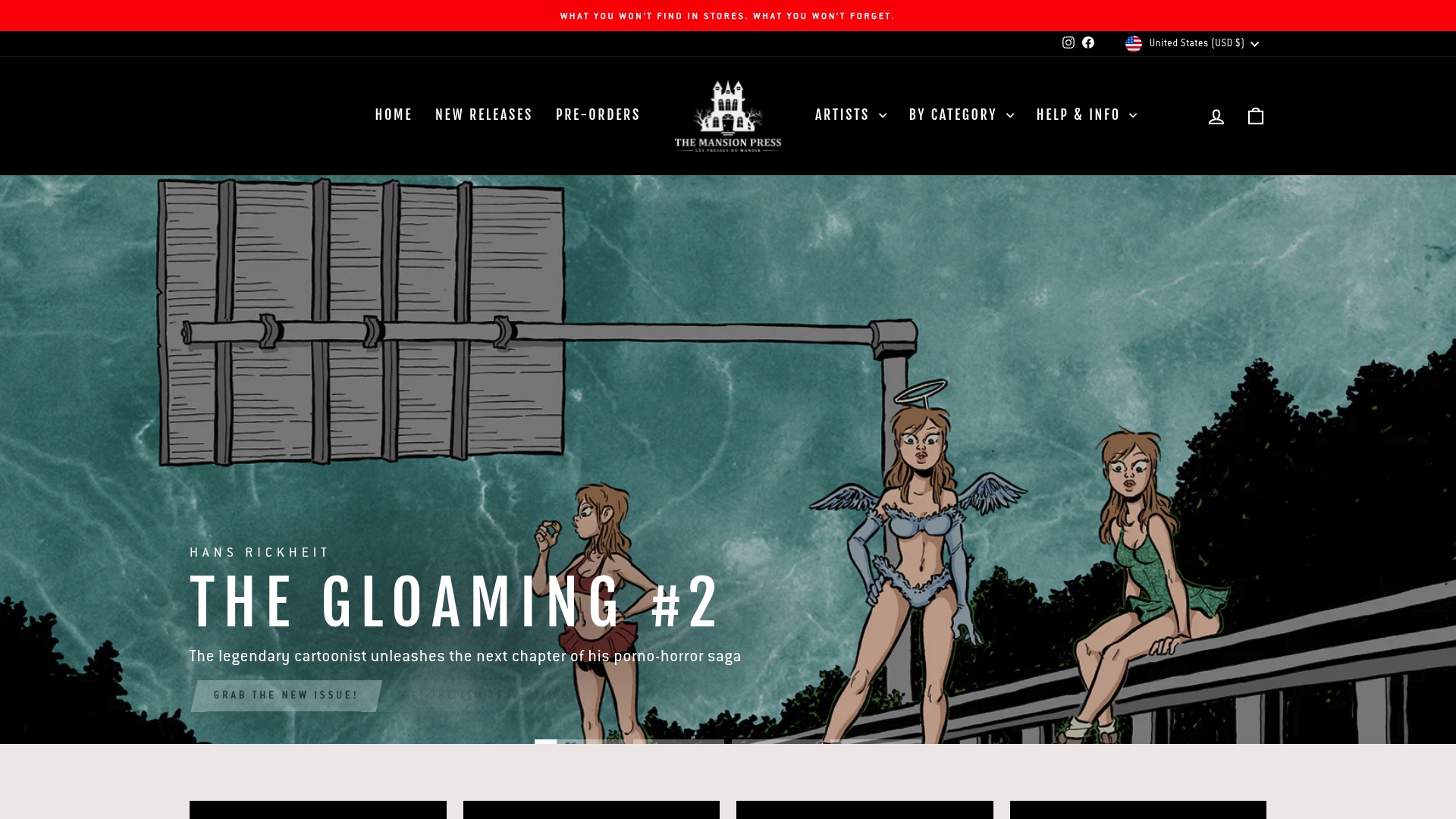Mastering Building an Artbook Collection: A Practical Guide
Building an artbook collection sounds like a simple quest for beautiful covers and rare editions. But most collectors do not realize that a focused collection dramatically increases long-term satisfaction and value—according to Artsy, successful collectors always start with a clear vision. Chasing every interesting book leads to chaos, not curation. The real magic happens when each artbook serves a purpose, building a collection that sparks excitement every time you look at your shelves.
Table of Contents
- Step 1: Define Your Collection Focus
- Step 2: Research Potential Artbooks
- Step 3: Develop A Budget And Purchase Plan
- Step 4: Acquire And Organize Your Artbooks
- Step 5: Review And Refresh Your Collection
Quick Summary
| Key Point | Explanation |
|---|---|
| 1. Define Your Collection Focus | Understand your artistic interests to curate a meaningful artbook collection. Explore genres and styles that resonate with you. |
| 2. Conduct Comprehensive Research | Utilize diverse sources to identify impactful artbooks that align with your collection goals. Engage with communities and online platforms. |
| 3. Establish a Budget and Plan | Create a realistic budget for artbook acquisitions to avoid impulsive buying while ensuring sustainable growth of your collection. |
| 4. Organize and Preserve Properly | Develop a systematic approach for acquiring and storing artbooks in optimal conditions to ensure their longevity and accessibility. |
| 5. Periodically Review Your Collection | Schedule evaluations to assess your collection’s relevance, condition, and alignment with your artistic vision, allowing for thoughtful refinement over time. |
Step 1: Define Your Collection Focus
Building an artbook collection begins with understanding your unique artistic interests and establishing a clear vision. This foundational step transforms random acquisitions into a curated, meaningful collection that reflects your personal aesthetic and passion.
Start by exploring your genuine artistic preferences. Consider the visual styles, genres, and mediums that genuinely excite you. Are you drawn to Japanese manga illustrations, classic Western comic art, conceptual design sketches, or contemporary digital artwork? Your collection should represent an authentic extension of your creative tastes.
Key Considerations for Collection Focus
- Genre Specificity: Decide whether you want a broad collection or a niche specialty
- Personal Connection: Select artbooks that resonate with your emotional and visual sensibilities
- Long Term Interest: Choose themes that will sustain your enthusiasm over years
Research becomes crucial in defining your collection’s scope. Visit museums, art galleries, online exhibitions, and artist portfolios to understand different artistic movements and styles. According to Artsy’s Collecting Guide, successful collectors develop a deep understanding of their chosen artistic domain before making significant investments.
Financial parameters also play a significant role in focusing your collection. Assess your budget realistically and determine whether you’ll pursue first editions, limited prints, signed copies, or more accessible volumes. Some collectors specialize in emerging artists, while others focus on established masters.
Documenting your collection goals helps maintain clarity and direction. Create a simple tracking system—whether digital or physical—where you can record potential acquisitions, note pricing trends, and map your collection’s evolution. This systematic approach prevents impulsive purchases and ensures each artbook meaningfully contributes to your overall collection narrative.
Verify your collection focus by checking three critical indicators: consistent theme, personal excitement, and potential for future expansion. If your selected artbooks make you genuinely enthusiastic, represent a coherent visual language, and offer room for future discoveries, you’ve successfully completed this crucial first step in building an artbook collection.
Step 2: Research Potential Artbooks
Researching potential artbooks transforms your collection from a casual hobby into a deliberate, thoughtful pursuit. This critical step involves discovering, evaluating, and understanding the artistic volumes that will form the cornerstone of your collection.
Begin by exploring multiple research channels that extend beyond traditional retail spaces. Online platforms, specialized art forums, museum bookstores, and professional artist websites offer rich sources of information. Academic libraries and art institution archives can reveal extraordinary publications that mainstream sources might overlook.
Digital Research Strategies
- Online Art Communities: Engage with forums dedicated to specific art genres
- Social Media Artist Follows: Track artist publications and recommended volumes
- Specialized Collector Websites: Join platforms that curate unique artbook recommendations
Develop a systematic approach to tracking potential acquisitions. Create a digital spreadsheet or dedicated notebook where you document interesting artbooks, including details like publication year, artist information, edition specifics, and estimated market value. This organizational method prevents overlooking significant discoveries and helps you budget strategically.
Networking plays a crucial role in advanced artbook research. Attend art book fairs, comic conventions, and gallery openings where collectors and artists converge. According to Library of Congress Research Guides, connecting with specialized communities provides insights beyond standard retail channels.
Understand the nuanced differences between various publication types. Limited edition art volumes often carry distinct value compared to mass market publications. Some collectors prioritize first print runs, signed copies, or volumes with unique artist annotations. Research the specific characteristics that elevate an artbook from merely interesting to truly collectible.
Technology offers powerful research tools. Utilize online databases, price tracking websites, and digital marketplaces to compare artbook availability and valuation. Set up price alerts for specific titles or artists, enabling you to track market trends and recognize exceptional acquisition opportunities.
Verify the completeness of your research by assessing three key indicators: comprehensive documentation, diverse information sources, and alignment with your collection’s defined focus. A successful research phase means you have identified potential artbooks that not only intrigue you but also contribute meaningfully to your growing collection’s narrative and aesthetic vision.
Step 3: Develop a Budget and Purchase Plan
Transforming your artbook collection vision into reality requires strategic financial planning and a disciplined purchasing approach. This step bridges your artistic passion with practical financial management, ensuring your collection grows sustainably and intentionally.
Start by conducting a comprehensive assessment of your financial resources. Determine a realistic monthly or quarterly budget specifically dedicated to artbook acquisitions. This budget should balance your collecting ambitions with other financial responsibilities, preventing impulsive spending that could strain your personal finances.
![]()
Budget Allocation Strategies
- Percentage Method: Allocate a fixed percentage of discretionary income
- Tiered Purchasing: Plan for different price point acquisitions
- Savings Approach: Create a dedicated artbook collection savings fund
Develop a nuanced purchasing strategy that considers multiple acquisition channels. Online marketplaces, specialized art bookstores, auction houses, and direct artist sales offer varied pricing and availability. According to Artbook Collector’s Guide, diversifying purchase sources helps collectors find unique volumes while managing overall spending.
Strategic Considerations for Purchasing Prioritize quality over quantity in your collection. Instead of purchasing numerous mediocre artbooks, focus on acquiring fewer, more significant volumes that genuinely represent your artistic interests. Research market values, understand edition specifics, and learn to recognize authentic, high quality publications.
Implement a tracking system to monitor your collection’s financial investment. Use spreadsheet software or dedicated collection management apps to record purchase prices, current market values, and potential appreciation. This approach helps you make informed decisions and understand the potential long term value of your collection.
Consider establishing purchase rules that align with your budget and collection goals. For instance, set a maximum spending limit per volume, create a quarterly acquisition cap, or develop a point system that balances rare finds with more affordable additions. These self imposed guidelines prevent financial strain while maintaining collection momentum.
Address potential financial challenges by building flexibility into your plan. Create contingency funds for unexpected opportunities, such as limited edition releases or auction discoveries. Some collectors rotate their collection periodically, selling less significant volumes to fund more meaningful acquisitions.
Verify the effectiveness of your budget and purchase plan by assessing three key indicators: consistent progress, financial sustainability, and alignment with your original collection vision. A successful plan means you are acquiring artbooks thoughtfully, without compromising your overall financial health, and steadily building a collection that brings you genuine artistic satisfaction.
Step 4: Acquire and Organize Your Artbooks
Acquiring and organizing artbooks transforms your collection from a scattered assortment into a carefully curated archive of artistic expression. This critical step involves not just purchasing volumes, but creating a systematic approach to preservation, display, and documentation.
Begin by establishing a dedicated space for your collection that provides optimal preservation conditions. Consider environmental factors like temperature, humidity, and light exposure. Direct sunlight and extreme temperature fluctuations can damage delicate artbooks, so select a controlled environment that protects your investment.
Essential Preservation Tools
- Archival Quality Shelving: Use acid free, stable materials
- Climate Control Devices: Maintain consistent temperature and humidity
- Protective Handling Accessories: White cotton gloves, book supports
Develop a comprehensive cataloging system that goes beyond simple shelving. Create a detailed digital inventory using spreadsheet software or specialized collection management applications. According to Conservation Center for Art and Historic Artifacts, documentation should include critical details like acquisition date, purchase price, edition specifics, condition notes, and provenance information.
Invest in professional grade protective materials that shield your artbooks from potential damage. Acid free archival boxes, protective sleeves, and carefully designed storage solutions prevent deterioration. Some collectors use museum grade preservation techniques, including controlled humidity environments and specialized handling protocols.
Organize your collection strategically. Consider multiple organizational frameworks such as chronological arrangement, artistic genre, publication type, or personal aesthetic preference. Your chosen system should make individual volumes easily accessible while maintaining the collection’s overall visual and conceptual integrity.
Implement a careful handling protocol for your artbooks. Always handle volumes with clean hands or white cotton gloves, support the spine when opening, and avoid placing excessive stress on binding mechanisms. Consider creating a dedicated viewing area with proper lighting and supportive book stands that minimize physical strain during examination.
Digital backup becomes increasingly important for serious collectors. Photograph each volume, create detailed digital records, and potentially scan select pages for personal reference. This approach provides an additional layer of documentation and protection against potential physical loss or damage.
Verify the success of your acquisition and organization efforts by assessing three key indicators: comprehensive documentation, preservation quality, and accessibility. A well organized collection means you can locate any volume instantly, understand its specific characteristics, and ensure its long term preservation while maintaining the ability to enjoy and study your carefully curated artbooks.
The following table summarizes important tools and materials recommended in the article for properly organizing and preserving your artbook collection.
| Tool/Material | Purpose | Notes |
|---|---|---|
| Archival Quality Shelving | Stores books in stable, acid-free conditions | Prevents damage over time |
| Climate Control Devices | Maintains consistent temperature and humidity | Protects against deterioration |
| Protective Handling Accessories | Allows safe book handling and minimizes wear | White cotton gloves, book supports |
| Acid-Free Archival Boxes | Shields artbooks from light, dust, and impurities | Recommended for rare/valuable books |
| Protective Sleeves | Provides an extra layer of protection for covers and pages | Useful for delicate or large volumes |
| Digital Inventory Software | Enables detailed documentation and tracking | Spreadsheets or dedicated collection apps |
| Photography Equipment | Documents and backs up collection visually | Optional but enhances digital records |

Step 5: Review and Refresh Your Collection
Reviewing and refreshing your artbook collection transforms it from a static archive into a dynamic, evolving artistic narrative. This critical step ensures your collection remains vibrant, relevant, and aligned with your original creative vision while adapting to new artistic discoveries and personal growth.
Schedule regular collection assessments, ideally twice annually. During these reviews, carefully examine each volume with a critical and objective perspective. Look beyond sentimental attachment and evaluate each artbook’s continued relevance to your collection’s core focus and aesthetic goals.
Collection Evaluation Criteria
- Artistic Alignment: Assess how each volume supports your collection’s theme
- Physical Condition: Check for potential preservation needs
- Market Value: Understand current valuation of your volumes
- Personal Resonance: Confirm ongoing emotional connection with each piece
Develop strategies for thoughtful collection refinement. Some collectors implement a rotation system where less significant volumes are traded, sold, or exchanged to make room for more meaningful acquisitions. According to Art Collectors International, periodic collection curation helps maintain quality and prevents stagnation.
Expand your collection’s horizons by staying connected with emerging artists and new publication trends. Attend art book fairs, follow specialized online platforms, and engage with artistic communities that align with your collection’s focus. This proactive approach prevents your collection from becoming outdated or disconnected from contemporary artistic expressions.
Financial stewardship becomes crucial during collection review. Research current market values of your volumes, track potential appreciation, and understand the economic dynamics of artbook collecting. Some collectors view their collection as both an artistic statement and a potential investment, making periodic financial assessment important.
Consider digital documentation as part of your review process. Update your digital inventory, refresh high resolution photographs, and reassess your cataloging system. Technology evolves rapidly, so ensure your documentation methods remain current and accessible.
Address potential emotional challenges during collection review. Letting go of volumes that no longer serve your collection’s vision can be difficult. Approach this process with objectivity, recognizing that collection evolution is natural and reflects your artistic growth.
Verify the success of your review and refresh process by assessing three key indicators: collection coherence, preservation quality, and continued personal inspiration. A successful review means your artbook collection remains a living, breathing representation of your artistic journey—dynamic, meaningful, and continuously evolving to reflect your changing aesthetic sensibilities.
Below is a checklist that can be used during your scheduled review to ensure your artbook collection remains relevant, preserved, and inspiring as suggested in the article.
| Review Criteria | What to Check | Completed (✓/✗) |
|---|---|---|
| Artistic Alignment | Does each volume support your core theme and vision? | |
| Physical Condition | Are all books free from damage and well preserved? | |
| Market Value | Is the market valuation for each volume up to date? | |
| Personal Resonance | Do you still feel a strong connection to each piece? | |
| Digital Records | Have you updated your digital inventory since last review? | |
| Organization | Is your collection easy to access and systematically arranged? | |
| New Acquisitions | Have you incorporated recent finds and let go of outdated works? |
Transform Your Artbook Collection With The Mansion Press
Are you ready to move beyond generic artbook shopping and start building a collection that matches your personal style and vision? If you have struggled with finding limited editions, authentic collector’s pieces, or direct artist collaborations as described in our guide on mastering artbook collecting, The Mansion Press can help you conquer those challenges. Our curated online selection lets you discover unique artbooks and comics by independent creators and established artists, including exclusive releases and upcoming pre-orders that rarely appear in traditional stores.

Take the next step to shape your dream collection. Browse our designer-crafted home page for one-of-a-kind artbooks, or explore showcases featuring works straight from artists themselves. Your future collection deserves the rare, visually stunning finds only available now. Visit The Mansion Press and start adding meaningful artbooks to your shelf today.
Frequently Asked Questions
How do I determine the focus of my artbook collection?
To define your collection focus, explore your genuine artistic preferences by considering styles, genres, and mediums that excite you. It’s essential to select artbooks that resonate with your personal aesthetic and will sustain your interest over time.
What research methods can I use to find potential artbooks for my collection?
Utilize a variety of channels such as online art communities, museum bookstores, academic libraries, and specialized collector websites. Create a digital spreadsheet to document interesting artbooks with details like publication year and estimated market value.
How should I budget for my artbook collection?
Conduct a thorough assessment of your financial resources to determine a monthly or quarterly budget for acquisitions. Consider allocating a fixed percentage of your discretionary income, planning for different price points, and even creating a dedicated savings fund for your artbook collection.
What are some effective ways to organize my artbook collection?
Establish a dedicated space considering environmental factors like temperature and humidity. Create a detailed digital inventory, use archival quality shelving, and organize your collection by genres, themes, or personal preferences to ensure easy access and preservation.

